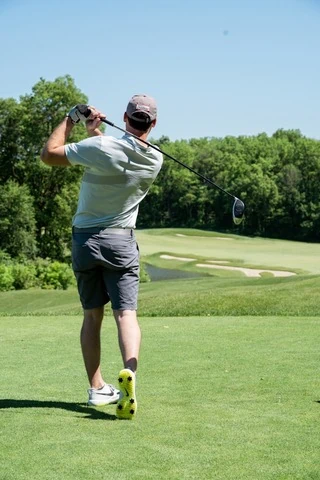
Golf is a sport that is both a leisure activity and a competitive challenge, often seen as a respite from the hustle and bustle of daily life. Nevertheless, pain can transform this serene pastime into a strenuous ordeal, leaving you longing for the days when you could play without discomfort. Before you consider hanging up your clubs, let’s explore some effective strategies to alleviate your pain.
With the right approach, you can address the root of your agony and swing your way back to the greens with confidence and ease. In the following sections, we’ll discuss the causes of golf-related pain and provide practical solutions to help you return to the game you love.
Understanding Golf-Related Pain
Recognizing the sources of pain in golf is crucial for finding the right solution. One common issue is poor form, which can lead to repetitive strain injuries. Another is the lack of proper warm-up before play, which prepares muscles and joints for the activity. Additionally, the overuse of certain muscle groups and not enough reliance on others can create imbalances and discomfort.
Before making any changes to your golf routine, it’s best to understand why you’re experiencing pain. Golf requires a unique combination of flexibility, strength, and technique. Any shortcomings in these areas can lead to increased stress on the body, resulting in pain. By pinpointing the underlying causes, whether it’s an issue of technique, physical fitness, or equipment, you can start taking steps to make your golf experience pain-free.
Lastly, do not underestimate the impact of previous injuries or chronic conditions, which can be exacerbated by the physical demands of golf. Consulting with the best physical therapist you can find can help you develop a personalized plan to address and manage your pain while playing golf. Plus, they can provide exercises and stretches specifically tailored to your needs.
Tailoring Your Warm-up Routine
A proper warm-up routine can dramatically reduce the risk of injury on the course. This should include dynamic stretches that target the muscles most engaged during a golf swing, such as the torso, shoulders, and hips, to improve the range of motion and increase blood flow to the muscles.
Your warm-up should also mimic the movements of golf to prepare your body for the specific physical demands. Practicing swings with a lightweight club or doing rotational exercises can improve mobility and help your muscles remember the correct movements during play. It’s important to give yourself enough time for a thorough warm-up so your body is ready to perform.
In addition to dynamic stretching and movement exercises, consider incorporating a short cardio element into your warm-up. This could be a brisk walk to the practice range or a gentle jog. Elevating your heart rate increases circulation, ensuring that your muscles are well-oxygenated and ready for the demands of a full round of golf.
Enhancing Flexibility and Strength
A balanced exercise regimen that builds flexibility and strength is key to avoiding pain related to golf. Improving flexibility, particularly in the hips, back, and shoulders, can significantly enhance your swing and reduce stress on the body. Yoga and Pilates are excellent for increasing flexibility and promoting muscular balance.
Strength training is equally important, with a focus on core muscles. A strong core provides stability in the golf swing and can help prevent back pain. Exercises like planks, rotational movements with resistance bands, and stability ball workouts can all contribute to a stronger core and a more powerful swing.
Remember to also focus on your lower body. Strong legs and glutes provide a solid foundation for your golf swing, helping to prevent over-reliance on your back and arms. Include exercises such as squats, lunges, and leg presses in your fitness routine to build endurance and power from the ground up.
 Refining Your Golf Technique
Refining Your Golf Technique
Working with a golf pro can do wonders for correcting your technique, which in turn can alleviate pain. They can spot and correct subtle flaws in your swing that may be contributing to discomfort. Even minor adjustments can make a significant difference in reducing strain on your body.
Incorporate the advice you receive into a consistent practice routine, focusing on muscle memory. This may include drills and exercises designed specifically to engrain the proper movements in your swing. Remember, changing a golf swing can take time and patience, so don’t be discouraged if progress seems slow at first.
Do not forget the short game. While the full swing gets a lot of attention, the bending, stooping, and twisting involved in putting and chipping can also contribute to pain. Ensure that you’re using proper posture and body mechanics even for these subtler aspects of the game.
Selecting the Right Equipment
The right golf equipment can significantly impact your comfort on the course. Clubs that are too long, too short, or improperly weighted can cause you to alter your natural swing, leading to pain and injury. Consider getting a custom fitting from a qualified professional to ensure your clubs are tailored to your physique and playing style.
Golf shoes are another important piece of equipment that can affect your game and your comfort. They should provide good support and stability, particularly through the arch and on uneven terrain. This can reduce the risk of foot and ankle pain, as well as provide a stable foundation for your golf swing.
Don’t overlook the importance of a good golf bag. Carrying a heavy bag can put undue stress on your back and shoulders. A pushcart or a bag with a dual-strap system can distribute weight more evenly and help prevent strain.
Developing a Recovery Strategy
Post-game care is as important as pre-game preparation when it comes to managing pain. Practices like applying ice to sore areas or engaging in gentle stretching can aid in recovery. This helps minimize inflammation and maintain flexibility after a long day on the course.
Adequate hydration and nutrition also play a vital role in recovery. Ensure you’re refueling your body with the right nutrients and staying hydrated to support muscle repair and overall health. This can also decrease the likelihood of muscle cramps and fatigue.
Consider integrating massage or physical therapy into your routine. These treatments can help alleviate muscle tightness, improve circulation, and address any specific pain points you have experienced. Regular sessions can be a proactive approach to keeping your body in top condition for golf.
Crafting a holistic approach to playing golf without pain is about harmonizing your warm-up routine, physical fitness, technique, equipment, and recovery strategies. By understanding and addressing golf-related pain from multiple angles, you can enhance your performance, extend your playing years, and most importantly, enjoy the game to its fullest. Embrace the journey of refining your technique, fortifying your body, and equipping yourself with the right tools.
With dedication and smart practice, the course can be a place of challenge and renewal, rather than discomfort and frustration. Remember, the ultimate goal is to relish every swing and cherish the walk on the greens under the open sky.

 Refining Your Golf Technique
Refining Your Golf Technique




